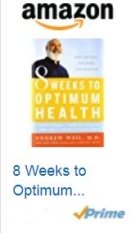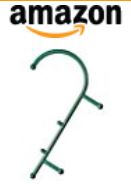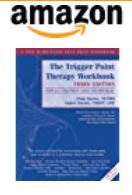Do you have muscle pain or discomfort at times throughout your day? "All the time!', you say. Are you by
chance like I was in saying "I take such good care of myself, so why do I hurt much ot the time? Do you feel you are personally
responsible for the stock price of the aspirin or anti-inflammatory drug manufacturers?
Well, you've come to the right spot! Based on my experience in dealing with acute muscle pain after a shoulder
operation in 2006, I learned to eliminate that pain, not just sometimes but all the time! During that period I learned:
That taking anti-inflammatories actually raises the pro-inflammatory/anti-inflammatory homeostasis!
That "omega 3s" supply you with the raw materials with which you can make your own anti-inflammatories!
Most, if not all, of muscle issues are due to muscle "trigger points"
That you can, by self-massage for about 10 - 20 minutes every day, eliminate said trigger points.
A surprising number of "Joint" issues are also due to muscle "trigger points". This
includes wrist pain (often blamed on things like "Carpal Tunnel Syndrome") and knee issues - "Trick Knee", "Weak Knee",
and the like - (often blamed on ligament problems).
Indeed, the "Self-Applied Massage" page (link is below) has two separate sections describing my success in eliminating
wrist joint and knee joint issues by releasing taut, contracted muscles - that is, trigger points - associated with both joints.
Three Steps
So, where do we start? Your course in eliminating muscle pain involves three steps:
Step 1: Learn how to release "trigger points" (contracted muscles), likely by visiting a professional body work person a few times,
to see how they do it.
Step 2: Add omega 3s to your diet. For most folks, this simply involves taking fish oil tablets, or eating cold water fish
two or three times a week.
Step 3: Learn how to do your daily "muscle work", which is a 10 - 20 minute self-massage, in part using the
Theracane tool.
I will cover these three steps in greater detail below.
And, of course, it wouldn't be the Wracklineblog without a "Going Deeper" section at the end!
I wish to leave you, my readers, with the confidence that you can:
Eliminate, or at least drastically reduce, muscle pain from your life.
Solve your own muscle issues with simple muscle work. So, when your "back goes out" or when you "pull a muscle",
you can self-treat the affected muscles rather than reach for anti-inflammatories and pain pills.
P.S. Backs don't "go out". Instead one or more muscles form a "trigger point" and tense up, and simply need to be released.
P.P.S. Joints don't "go out". At least not all the time. Often some muscles near the joint tense up and simply need to be
released.
Your commitment, in order to achieve these goals, is to be willing to do about 10-20 minutes of muscle
work each day. This is the self-applied massage, with one or two stretches afterwords.
Well, there might be another commitment: dietary change. This is actually a two-part approach to eliminating muscle pain.
The first part is the muscle work and the second part is to avoid the types of foods that cause inflammation.
Another reason to eliminate muscle pain is that muscle pain is the best argument that we use to convince ourselves that we are getting old! It's very important to eliminate the "O" word from our vocabulary!
So now I experience this "buffer effect" on a fairly regular basis. For example, I might feel a slight headache coming up,
due perhaps to a bit too much yardwork (and not enough water to dilute the excess toxins). I think about taking an aspirin
like I used to, but soon I forget about it because the headache just goes away. Or perhaps I piss off a muscle doing the
same yardwork. I find that - rather than reach for the aspirin - I just go work the affected muscle with the Theracane,
and soon the pain simply subsides.
(What's a "Theracane"?, you ask. I'll explain soon.)
Important note (I learned the hard way!):
In switching to "natural" compounds, don't stop taking the NSAIDs suddenly! Why? Because of the reason described
above: the constant intake of anti-inflammatories has raised the homeostatic level higher. Your physicality is cranking out more
inflammatories to counteract the powerful anti-inflammatories. If the anti-inflammatories stop, there is temporarily an
abnormally high level of inflammation. I really hurt when I made this mistake!
Trigger Points
The key to all of this is learning about muscle trigger points and their treatment. In the
Trigger Point Therapy Workbook, by Clair and Amber Davies, we find that a trigger point is a "highly irritable
localized spot of exquisite tenderness" involving a taut band of muscle tissue.
Put simply, trigger points are small regions of tension and contraction where your muscles have "knotted up on ya".
In some cases, you can feel these regions, either as a small knot or - less commonly - as a taut rope.
Trigger points sound simple, but their effects can be devastating - you can't bend over to pick up things, can't reach up to the top shelf,
can't sit comfortably, can't sleep well, and you hurt. This is mainly because, although the "trigger point" may be a
small spot, the entire muscle is tightly contracted.
Medical science might claim that you have arthritis, tendinitis, bursitis, joint or ligament injury, or bad spinal disks,
and its solutions range from pain pills, muscle "relaxants", and even operations.
But the solution might be as simple as correctly applied pressure and massage.
So . . .how do you "work" a trigger point?
The best way to learn how to do this is to go get a trigger point massage from a professional. (This may be also be
referred to as a "neuromuscular massage", "deep tissue massage", or even "accupressure massage".) This way
you can get valuable information about where trigger points are, and you can observe firsthand how to apply
pressure to release them. Another benefit of having such a massage is that they work. During my time of severe
muscle pain, the trigger point massage gave me my first big relief, and the first night of decent sleep.
Note: Trigger point massages can be "uncomfortable", especially if it is your first one. Reasons for this: Remember
the definition of a trigger point - "a highly irritable localized spot of exquisite tenderness". The masseuse will be finding
all these tender locations, and pressing fairly firmly on each one of them. The masseuse will also be uncovering lots
of old dormant triggers in other areas. So an aspirin might be in order before you start!
So, before we start with the self-applied massage pictures, here are the two "Tools of the Trade":
The Self-applied Massage
Got Acute Trigs? Need More Tips?
Does it seem like you're just making it worse? Do you feel like "I'm nothing but
an ambulating |
 |
So, let's take this a little deeper...
Turning a negative into a positive:
All this business of self-applied massage and muscle work can be seen as turning a negative
into a positive. The negative was the constant low grade inflammation and recurring muscle pain.
The positive is the ability to be free of muscle pain and especially to effortlessly release muscle
pain that comes up, using a bit of massage and/or Theracane work.
There are other examples of this as well:
For example, somewhere in my mid-40s I began to notice that it was becoming more and
more difficult to go up stairs. "Well, It's started: I'm finally getting older", I said at first. Fortunately I had already
learned that this is the sort of language by which we DO grow old, and that our words - spoken with the
authority of the Universal Consciousness - can create things like "age". So I countered that by beginning
to adopt a habit of going up stairs on purpose, two at a time no less. Soon I became a regular fixture on
the less-traveled staircase at my place of work.
The effect is that ever since then, stairs are no longer a problem. Indeed, I use stairs as a form of cardio exercise!
As another example, I experienced several extremely discomforting vertigo episodes somewhere
in my late 30s. I would look with envy and isolation at other drivers thinking, "I wish I could take balance for
granted again."
But after some research, I began to do daily balance exercises (after the morning muscle work).
After a while the continual fear of dizziness episodes passed, and now I experience better balance than
I did when younger! I have an article on Vertigo in the "Health and Nutrition" section of my blog.
Please forgive the sudden barrage of the pronoun "I"! But the intention is to give some examples of
turning negatives into positives.
Suppose for example you find that getting up from a squat is becoming more
and more difficult, more and more likely to be accompanied with an "Uh!" Or, you find that you are reaching
for something to help yourself get up most of the time.
Well, you can use your trusty ol' stairs to fix this! Simply go down the stairs slowly! Place
one foot near the next stair down, but hold yourself with your knee bent and the foot suspended just above
that stair. Hold for a second or two and then put your weight on the foot. Go down the stairs this way.
Repeat this by going up and down the stairs a few times. Try it sometimes while holding 8 or 10 lb weights.
After a few weeks of doing this several times a day, it'll be "What problem getting up from
a squat?" Note also that going down some stairs slowly, suspending yourself with one foot, helps improves
your balance too.
And finally, one last thought:
Try to do your muscle work with a little "mindfulness". No daydreaming about what you are going
to do later in the day. At least: NO work-related musings!
Copyright © 2018 J.A.



